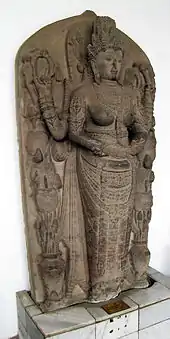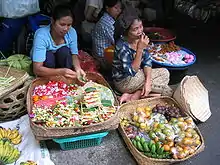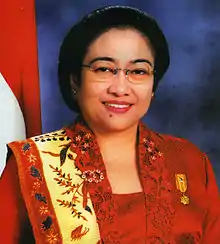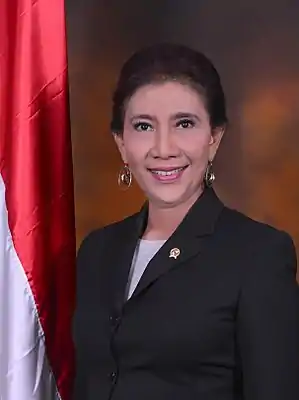Women in Indonesia
The roles of women in Indonesia today are being affected by many factors, including increased modernisation, globalisation, improved education and advances in technology. Many Indonesian women choose to reside in cities instead of staying in townships to perform agricultural work because of personal, professional, and family-related necessities, and economic requirements. These women are moving away from the traditional dictates of Indonesian culture, wherein women act simply and solely as wives and mothers. At present, the women of Indonesia are also venturing actively into the realm of national development, and working as active members of organisations that focus and act on women's issues and concerns.[2][3]
.jpg.webp) Indonesian women often run small business to support their family, such as traders in marketplace or as street vendors. | |
| Gender Inequality Index | |
|---|---|
| Value | 0.494 (2012) |
| Rank | 106th |
| Maternal mortality (per 100,000) | 220 (2010) |
| Women in parliament | 22.5% (2019) |
| Females over 25 with secondary education | 48.9% (2012) |
| Women in labour force | 51.2% (2011) |
| Global Gender Gap Index[1] | |
| Value | 0.691 (2018) |
| Rank | 85th out of 153 |
History

In Indonesian society, women performed vital roles both within and outside the family. In rural native society, certain positions, such as dukun beranak (traditional midwife), traditional healer, ritualist, and shaman, are often held by women. Despite their roles seeming to being reduced, if not rather confined, after the adoption of somewhat patriarchal cultures of Hinduism, Buddhism, Islam, and Christianity, women still hold important positions, especially within families.
In Balinese society, women traditionally play important roles, especially concerning family and economic life. Despite traditional values that hold Balinese women responsible for fostering balance and harmony within families and producing high-quality offspring, in a fast changing society, their economic role has grown.[4] It is common for Balinese women to pursue economic activities outside of their household; thus, Balinese traditional marketplaces are filled with women running businesses.
The Minangkabau people are known as one of the few traditional societies that apply matriarchal and matrilineal culture, where property and family names are inherited from mother to daughter, and husbands are considered as "guests" in their wives' household.[5] Its culture also recognises a prominent historic female figure, Bundo Kanduang, the matriarch of Minangkabau society. Today, Bundo Kanduang refers to the traditional institution consisting of female elders revered in the adat (tradition) of Minangkabau society.[6]
In Indonesian history, there are records of some prominent women that held and exercised considerable power and influence within their society, although usually reserved wxclusively for an elite ruling class. They include Queen Shima of Kalingga Kingdom (c. 7th century), Pramodhawardhani of Medang Kingdom (c. 9th century), Isyana Tunggawijaya of Medang Isyana dynasty (c. 10th century), Mahendradatta of Bali (c. 10th century), Ken Dedes of Singhasari (c. 13th century), also queens of Majapahit (c. 13th-15th century); Gayatri Rajapatni, Tribhuwana Wijayatunggadewi and Suhita. Following the arrival of Islam in Java, Ratu Kalinyamat of Jepara was also a notable female leader. Sultanate of Aceh also recorded several sultanas that ruled the region. Indonesia has recognised several historic national heroines that fought against Dutch colonialism; among others are Nyi Ageng Serang, Martha Christina Tiahahu, Cut Nyak Dhien and Cut Nyak Meutia.

The women's emancipation movement was started in late 19th century colonial Dutch East Indies, when a handful of upperclass native women advocated for women's rights and education for women. These women's right pioneers are Kartini of Jepara and Dewi Sartika of Bandung, who both established a school for girls.[7](p5)
Women's suffrage was never an issue in Indonesia. Since its first election in 1955, women have held equal legal rights with men in politics, although politics is still a male-dominated field in practice. In 2001, Megawati Sukarnoputri—then serving as Vice President—became the first female president of Indonesia after the removal of President Abdurrahman Wahid.[7](p1)
On 5 May 2015, following a Royal Decree issued by the Sultan, Princess Mangkubumi (previously known as Princess Pembayun) received the new name Mangkubumi Hamemayu Hayuning Bawana Langgeng ing Mataram. This denotes her as the heiress presumptive to the throne of Yogyakarta.[8] The title Mangkubumi was formerly reserved for senior male princes groomed for the throne, including the reigning Sultan. The decree thus admits female royals into the line of succession for the first time since the inception of the Sultanate. According to the current Sultan, this was in line with his prerogatives; his action was nonetheless criticized by more conservative male family members such as his siblings, who were thus displaced in the line of succession.[9]
Women's rights
| Part of a series on |
| Women in society |
|---|
 |
Indonesia signed the Convention on the Elimination of All Forms of Discrimination Against Women in 1980 and ratified it in 1984.[10]
National law and sharia
The Indonesian National Commission on Violence Against Women (Komnas Perempuan) noted that more regulations that discriminate against women are being adopted throughout the country than are being repealed. [11] In 2012, the Commission noted 282 bylaws in various jurisdictions across Indonesia that it deemed discriminatory, compared with 154 such instruments in 2009.[11] There are 96 that impose criminal sanctions on women through regulations on prostitution and pornography, 60 that contain dress codes and religious standards, and 38 that place restrictions on women’s mobility.[11] Although such bylaws can be found in 28 Indonesian provinces, the six provinces in which they are largely concentrated are East Java, South Kalimantan, South Sulawesi, West Java, West Nusa Tenggara, and West Sumatra.[11]
In many parts of Indonesia, local laws compelling women and girls to wear the hijab are increasingly in place in schools, government offices and public spaces.[12] Aceh province has implemented Sharia law in full,[13] where all Muslim women must wear the traditional head covering known as hijab, and fraternising with the opposite sex outside marriage is banned.[14]
Sexual crime, harassment, and trafficking
More than 90% of rape cases in Indonesia go unreported, with victims fear being blamed.[15]
Sex trafficking in Indonesia is a problem. Indonesian and foreign women and girls have been forced into prostitution in brothels and homes and been physically and psychologically abused.[16][17][18]
Women-only transport

Since 2010, the Indonesian Railway Company (PT Kereta Api Indonesia) introduced women-only carriages on some commuter trains in the Jakarta metropolitan area in response to reports of sexual harassment in public places, including commuter trains and buses.[19] The women-only carriages on commuter trains are usually denoted by large pink or purple stickers, which read "Kereta Khusus Wanita". This kind of carriage was previously only able to be found on air-conditioned EMUs (which only provides women-only carriages on each end of the train), but a number of recently repaired non-air conditioned EMUs have also been equipped with the women-only carriage stickers.
In 2012, the company launched women-only trains.[20] However, this practice ended the following year after reports found that mixed-use cars were overcrowded during rush hour while women's only cars were underutilised.[21]
Marriage and family life

Dowry is rarely practiced in Indonesian culture, yet bride price is practiced by certain ethnic groups. For example, the uang panai bride price in Bugis culture. The price paid is based on the education, career, beauty, social and economic strata, or noble background of the bride.[22] In Minangkabau matrilineal culture, the payment of the "groom price", is given to the groom's parents, as the husband is entering his newly wed wife's household, and is also based on the education and career of the groom. The custom is called bajapuik or uang japuik, although historically a widespread practice in Minangkabau land, today only people of Pariaman that continue to practice this custom.[23] The more commonly prevailing national culture is the marriage gold (mas kawin) or mahar which refer to a gift provided by the groom to be given to the bride. It may contain a sum of money or gold, sometimes because of the adoption of Islamic culture, also include or replaced by symbolic religious items such as praying equipment (seperangkat alat sholat).[24]
As with many other developing countries, high fertility rate is a major problem.[25][26][27] Traditionally, Indonesian society has viewed children as a source of fortune.[25] A local saying that more children equated to more fortune and it was widely believed that the use of contraceptives contravened religious and moral values.[28][29] This contributed to a very high fertility rate, recognising that it was a major factor in creating widespread poverty.[30] Child marriage is also common.[31] It is among the triggering factors of diseases in women such as cervical cancer,[31] and is sustained by traditional norms.[32]
Health and welfare
_in_Djakarta_een_congres_dat_door_alle_afdelingen_in_Indonesi%C3%AB_werd_bijgewoond_TMnr_10000216.jpg.webp)
Many pregnant women in Indonesia do not have the financial capability to pay for hospital deliveries and birthing by Caesarean section, because of disproportionate salaries and medical expenses. Thus, these women require the support and assistance of "birth sanctuaries" that provide "free prenatal care, birthing services and medical aid", such as the Healthy Mother Earth Foundation (Yayasan Bumi Sehat) health clinics established by Robin Lim, an American midwife, in 2003. Such 24-hour nativity havens, mostly located in Bali and Aceh, help Indonesian women to escape the common practice of private hospitals in Indonesia that entails detaining newborn infants until medical bills are fully remunerated by the mothers.[33]
Nonetheless, the economy now seems to be improving (high GDP growth in 2012 as high as 6.2%)[34] and some programs had been done by the government to help promote the health and welfare of women and children. A ministry that specifically concerns in the field had been established for a long time since the regime of the late President Suharto during the New Order.[35]
Employment

In Indonesian culture, it is a social norm for husbands to economically provides for his wife and the whole family. Which means husband's earnings is expected to be given to the wife monthly and to be managed by her for family spending and savings. However, it is normal for women to pursue economic activity. For example, warung, a small scale family-owned store, is often run equally by men or women. In most parts of the country, Indonesian women traditionally enjoyed a degree of social and economic freedom. To support their family's economy, Indonesian women are involved in economic activities outside of their households, although mostly informal small-scale business. It is common to find women run businesses in traditional Indonesian marketplaces.

After a surge of foreign multinational investors began investing in Indonesia during the 1970s, many Indonesian women became the "prime workforce" and a source of cheap labourers in manufacturing businesses.[3] In the 1990s, some women in Indonesia, including adolescents and the homeless, resorted to engage in employment as sex workers and housemaids due to financial hardship. Some of the women who were forced into such work opted to go abroad to countries such as Saudi Arabia, Malaysia, Hong Kong, and Taiwan. A rather unfortunate few have since become victims of torture, sexual abuse, murder, illegal detention, rape, sodomy, and other forms of sexual assault. Health-wise, as a consequence of becoming prostituted by human traffickers, some have contracted HIV/AIDS and other sexually transmitted diseases.[36]

Indonesia is among the countries which have had a female president; Megawati Sukarnoputri served as president of Indonesia from 2001 to 2004. In 2012, 18% of national parliament representatives were held by women.[37] Tri Rismaharini is one example of the rising numbers of female leaders throughout Indonesia. More and more women are becoming scholars. The ratio of girls to boys in primary and secondary schools is also even as of 2013.[38] More scholarships awarded by the Indonesian government (and some other institutions other than the government) were given to women, and resulted in higher achievement in their later life. In most major cities like Jakarta and Surabaya, educated female workforce tend to postpone marriage, and girls who finish secondary school are six times less likely to marry early.[37]

Indonesian women could be making considerable shifts to national employment - women currently hold 33% of non-agricultural employment as they also work in the prestigious and traditionally male-dominated field such as architecture, medicine, and engineering.[39] Indonesian women have pursued various lines of work and some have excelled in their careers. These include economists such as Sri Mulyani Indrawati and Mari Elka Pangestu, Olympic gold medalist such as Susi Susanti and Liliyana Natsir, to activists such as Butet Manurung and Yenny Wahid. During the administration of President Joko Widodo, Indonesia had 26% female representation among state ministers, the highest among the 10 most populous countries. Indonesia has increasingly put women in senior roles in the government, business and finance. They include Finance Minister Sri Mulyani Indrawati, Foreign Minister Retno Marsudi, Maritime and Fisheries Minister Susi Pudjiastuti, and Bank Indonesia's deputy governor, Rosmaya Hadi.[40]
See also
- Pertiwi Cup, Indonesian women's football Tournament
- Indonesia women's national football team
- Femina, a weekly women's magazine
- Wanita Indonesia
- Gerwani
- Kebaya
General:
References
- "The Global Gender Gap Report 2018" (PDF). World Economic Forum. pp. 10–11.
- Ingham, Xylia (2005). "Career Women in Indonesia: Obstacles Faced, and Prospects for Change". Australian Consortium for 'In-Country' Indonesian Studies. Retrieved 6 May 2011.
- Ahmad, Abdul Razak (29 December 1998). "Redefining the role of women in Indonesia". New Straits Times. Third World Network. Retrieved 6 May 2011.
- Luh Ketut Suryani (2004). "Balinese Women in a Changing Society". The Journal of the American Academy of Psychoanalysis and Dynamic Psychiatry. 32: 213–230. doi:10.1521/jaap.32.1.213.28335. PMID 15132200.
- Rathina Sankari (22 September 2016). "World's largest matrilineal society". BBC.
- "Perempuan Minangkabau". Harian Haluan. 23 January 2016.
- Kathryn May Robinson; Sharon Bessell (2002). Women in Indonesia: Gender, Equity and Development, Volume 8 dari Indonesia assessment series. Institute of Southeast Asian Studies. ISBN 9789812301581.
- Slamet Susanto (6 May 2015). "Sultan names eldest daughter Crown Princess". theJakartapost.com. Retrieved 22 December 2015.
- John Monfries (12 June 2015). "The Sultan's Coup". anu.edu.au. Retrieved 22 December 2015.
- Zahra, Tri Inaya. "The Implementation of CEDAW Related to Women's Quota in Indonesian Parliament". Academia.edu. Retrieved 10 December 2016.
- "Indonesia: Commission Finds Many Laws that Discriminate Against Women". Global Legal Monitor. Library of Congress. 19 September 2012.
 This article incorporates text from this source, which is in the public domain.
This article incorporates text from this source, which is in the public domain. - Harsono, Andreas (25 November 2014). "OPINION: Indonesian women's rights under siege". Al Jazeera America. Retrieved 10 December 2016.
- Iaccino, Ludovica (31 October 2016). "Indonesian woman lashed for standing too close to her boyfriend in violation of Sharia law". International Business Times. Retrieved 10 December 2016.
- Topsfield, Jewel (7 April 2016). "Ban on outdoor music concerts in West Aceh due to Sharia law". The Sydney Morning Herald. Retrieved 10 December 2016.
- Beh Lih Yi (25 July 2016). Whiting, Alex (ed.). "Over 90 percent rape cases go unreported in Indonesia - poll". Thomson Reuters Foundation. Retrieved 10 December 2016.
- "Indonesia's child prostitution problem". The ASEAN Post. 9 February 2020.
- "Human Trafficking In Indonesia: The Difficult Road Home". Nexus Institute. 16 June 2017.
- "Facebook used to kidnap girls for sex slaves". Standard-Examiner. 29 October 2012.
- "Indonesia Railway Company Launches Women-Only Carriages". thejakartaglobe.com.
- Yulianto, Charles (1 October 2012). "ジャボデタベク電気鉄道センター: Operasi Perdana Rangkaian Khusus Wanita - 女性専用編成最初運転". charleskkb.blogspot.com.
- "What Real Women Think Of Women-Only Train Carriages". marieclaire.co.uk. 24 August 2017.
- Hendra Cipto (13 March 2017). ""Uang Panai", Tanda Penghargaan untuk Meminang Gadis Bugis-Makassar". Kompas.com (in Indonesian).
- "Uang Japuik, Tradisi Unik 'Beli' Laki-laki dari Ranah Minang". Otonomi.co.id (in Indonesian).
- "Mahar dengan Seperangkat Alat Sholat". Republika (in Indonesian). 26 July 2011.
- "Social and Demographic Issues in Indonesia – Future Directions International". 27 August 2015.
- http://www.copenhagenconsensus.com/sites/default/files/indonesia_packet_population.pdf
- "Indonesia" (PDF). keio.ac.jp.
- http://jurnal.ugm.ac.id/jurnal-humaniora/article/download/1808/1625
- http://www.oxis.org/m-z/idrus-2004.pdf
- https://www.adb.org/sites/default/files/publication/28140/asra02.pdf
- "Child marriage a serious problem in Indonesia". The Jakarta Post. 20 July 2016. Retrieved 10 December 2016.
- "9-10 June: Child Marriage, Sexual Moralities and the Politics of Decentralization in Indonesia - News - Research". Universiteit Leiden. Retrieved 10 December 2016.
- Ruffins, Ebonne (10 March 2011). "CNN Heroes: 'Mother Robin' delivers for poor women in Indonesia". CNN. Retrieved 6 May 2011.
- "Indonesia". worldbank.org.
- http://www.indonesia.go.id/in/kementerian/kementerian/kementerian-negara-pemberdayaan-perempuan-dan-perlindungan-anak/1647-profile/274-kementerian-pemberdayaan-perempuan-dan-perlindungan-anak
- "Indonesia". Coalition Against Trafficking in Women. Retrieved 6 May 2011.
- Bachelet, Michelle. "Women are integral part of Indonesian success". UN Women. Retrieved 18 November 2013.
- "Ratio of girls to boys in primary and secondary education (%)". The World Bank. Retrieved 18 November 2013.
- "Share of women employed in the nonagricultural sector (% of total non-agricultural employment)". The World Bank. Retrieved 18 November 2013.
- "Indonesia, world's biggest Muslim country, puts more women into senior roles". The Straits Times. 25 July 2017.
Further reading
- Poverty Reduction and Social Development Division. Poverty and Social Development Paper No. 1. Sociolegal Status of Women in Indonesia, Malaysia, Philippines, and Thailand. Asian Development Bank.
- Robinson, Kathryn May and Bessell, Sharon. Women in Indonesia: Gender, Equity and Development. Indonesia Assessment Series. Institute of Southeast Asian Studies (2002). 284 pages.
- 2 men, 2 women caned in Indonesia for sex offenses. The Jakarta Post. 5 May 2011.
External links
| Wikimedia Commons has media related to Women of Indonesia. |
